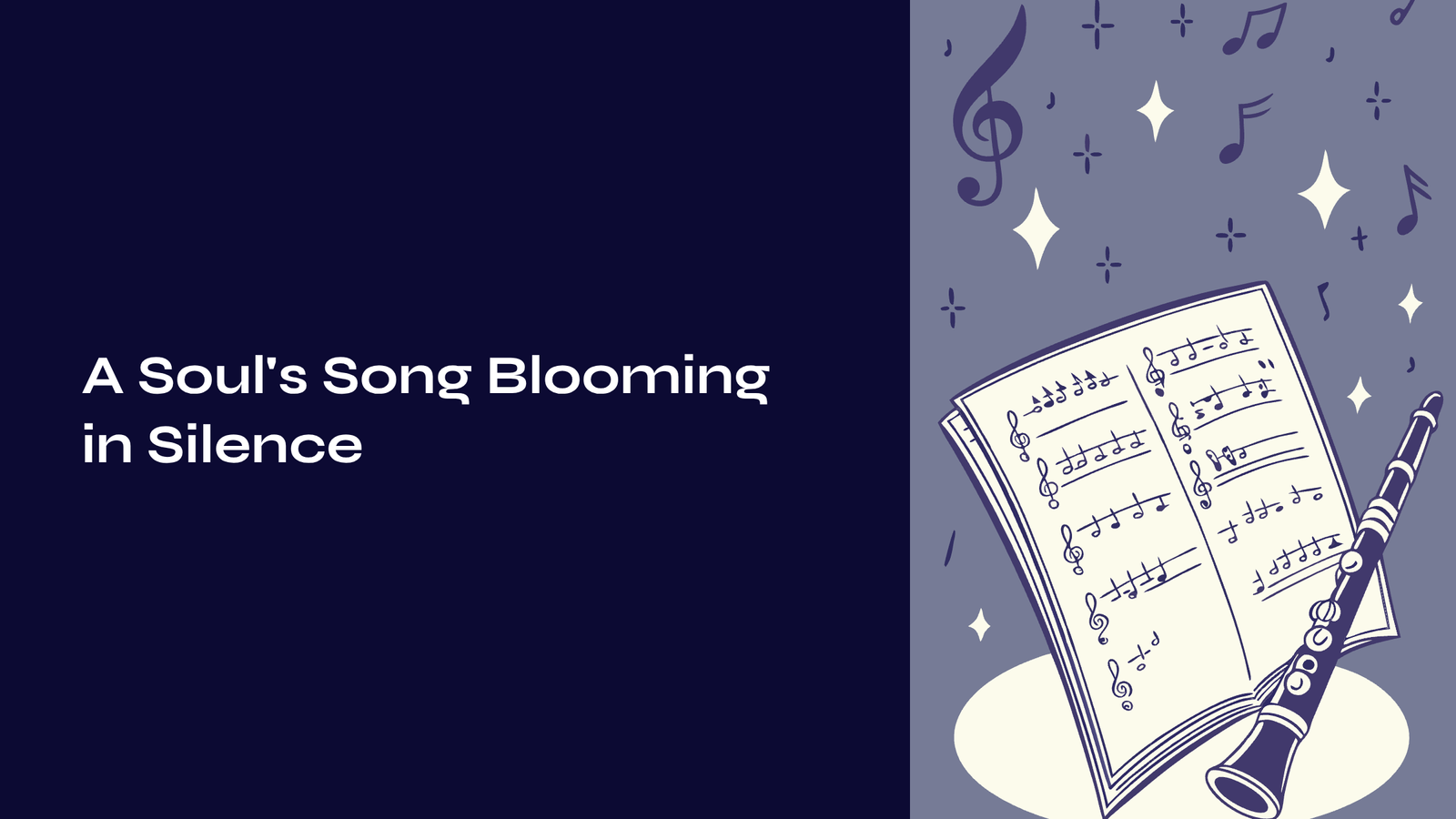Table of Contents
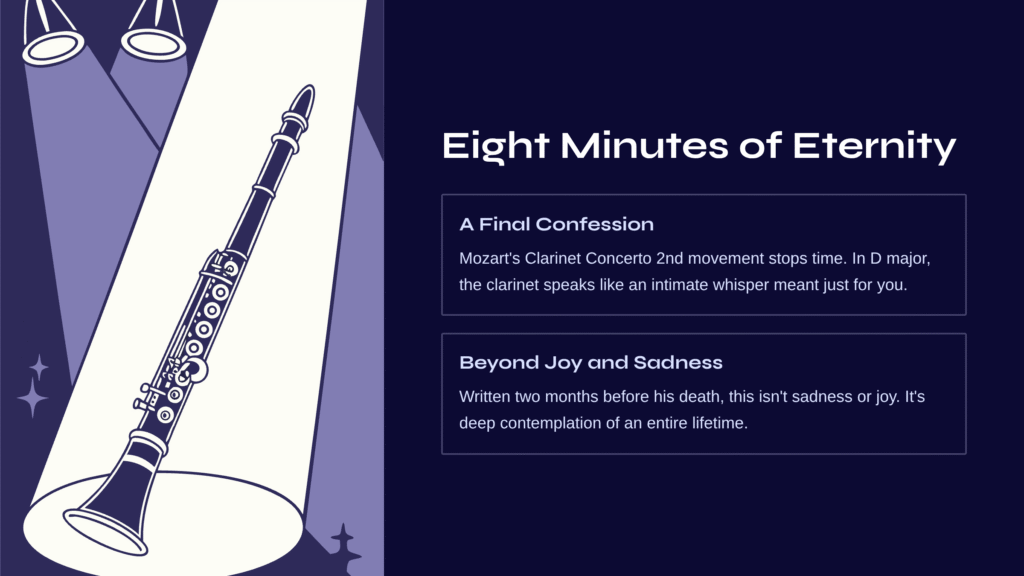
Eight Minutes of Eternity, or a Final Confession
Some music stops time. Mozart’s Clarinet Concerto 2nd movement Adagio is exactly that kind of piece. In this roughly eight-minute composition written in D major, all the world’s noise fades away, leaving only the voice of the clarinet. Like an intimate confession whispered just for you.
What did Mozart feel when he wrote this movement in the autumn of 1791, just two months before his death? As the first note quietly resonates, we hear the final whisper of a musical genius. It’s neither sadness nor joy, but the sound of deep contemplation that penetrates an entire lifetime.
Every time I listen to this movement, I wonder: isn’t this what true beauty is? Not flashy or stimulating, but something unforgettable once heard. That’s what this music represents.

A Genius’s Final Autumn and a Gift for a Friend
Understanding the background of Mozart’s composition of this Adagio makes the music even more special. In October 1791, after completing performances of La clemenza di Tito in Prague, he finished this concerto for his friend Anton Stadler. Stadler wasn’t just any performer—he was a master of the “basset clarinet,” a very special instrument.
The basset clarinet extends the lower register beyond that of a regular clarinet. It can produce notes three semitones lower than the standard A clarinet’s lowest note, reaching down to C, creating deep resonances comparable to a cello. Mozart was completely enchanted by this instrument’s unique charm, particularly the human voice-like timbre of its low register, called the “chalumeau.”
Therefore, this 2nd movement is essentially tailor-made music for the basset clarinet. While it can be performed on a regular clarinet, it loses the deep low notes originally intended. It’s like a painting missing its most important color.

A-B-A’: Perfect Design Hidden in Simplicity
The structure of the 2nd movement is remarkably simple: A-B-A’ form, a three-part structure of theme-contrasting section-theme return. Yet this simplicity is precisely where Mozart’s genius shines.
A Section (measures 1-16): The clarinet alone quietly sings the theme. In D major’s warm light, a melody pure and unadorned as a hymn flows forth. The orchestra holds its breath, then gently echoes the theme after the clarinet’s song ends.
B Section (measures 17-52): Here magic happens. Suddenly modulating to B minor, the atmosphere completely transforms. The basset clarinet begins in deep low notes and soars through an 11th leap to the high register. The drama of this moment! Like throwing a stone into a still lake, ripples spread outward.
A’ Section (measures 53-74): The original theme returns, but now clothed in richer ornamentation. Like retelling the same story but with deeper emotion this time.
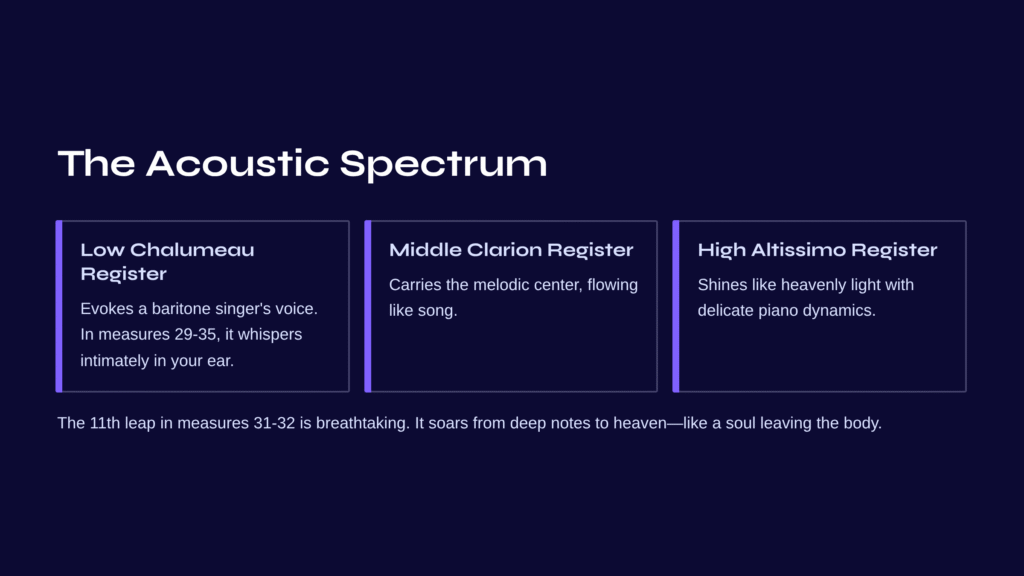
The Acoustic Spectrum Painted by Basset Clarinet
The true charm of this movement lies in the diversity of timbres created by the basset clarinet.
In the low chalumeau register, it evokes the human voice, particularly the soft timbre of a baritone singer. When these low notes appear in measures 29-35, that depth and warmth! It’s as if someone is whispering right in your ear.
The middle clarion register carries the melodic center, flowing like song. And in the high altissimo register, it shines quietly like heavenly light with delicate piano dynamics.
The 11th leap occurring in measures 31-32 is a breathtakingly beautiful moment. That instant when it suddenly soars from deep low notes to heaven—it feels like the soul leaving the body.
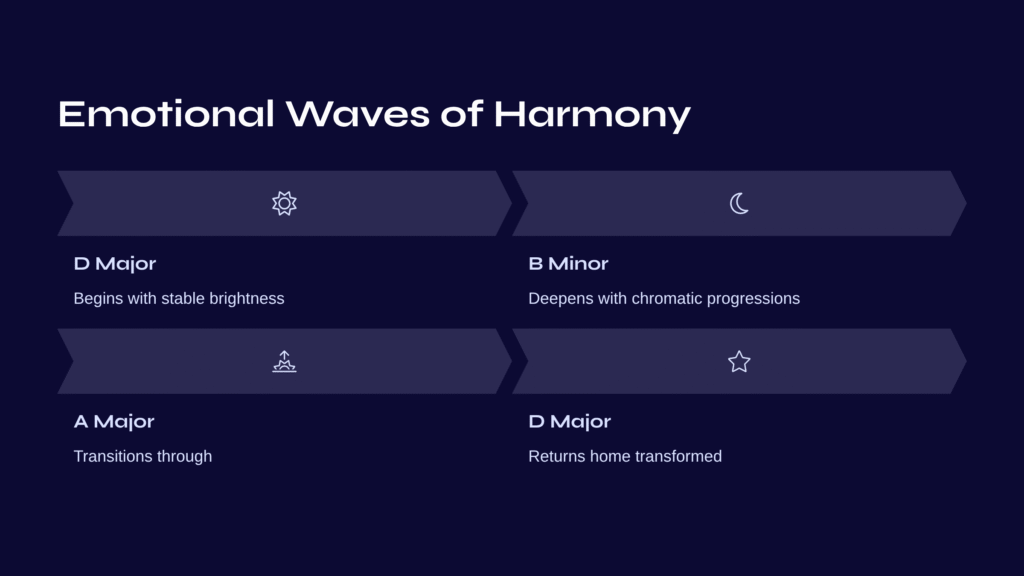
The Emotional Waves Told by Harmony
Within this brief movement, Mozart shows us an amazing harmonic journey. It begins with D major’s stable brightness, but in the B section deepens into B minor, then passes through A major before returning to the original D major.
Particularly heart-stirring are the chromatic progressions used in the B section. Advanced harmonic techniques like Neapolitan sixth chords and augmented sixth chords blend naturally, making them technically complex yet completely natural to the ear. Like voice tones naturally changing during conversation.

The Comfort I Found in This Music
For me, this Adagio is music of consolation encountered in “complete silence.” Especially on nights after difficult days, listening to this music calms my heart.
When the clarinet’s first theme emerges, it feels like someone placing their hand on my shoulder saying, “It’s okay, everything will pass.” And when the B section’s low notes resonate, I realize that sadness too is part of beauty.
Most of all, this music makes me think about “time.” In just eight minutes, Mozart shows us the entire spectrum of emotions a human being can feel. And when those eight minutes end, it feels like returning from a long journey.
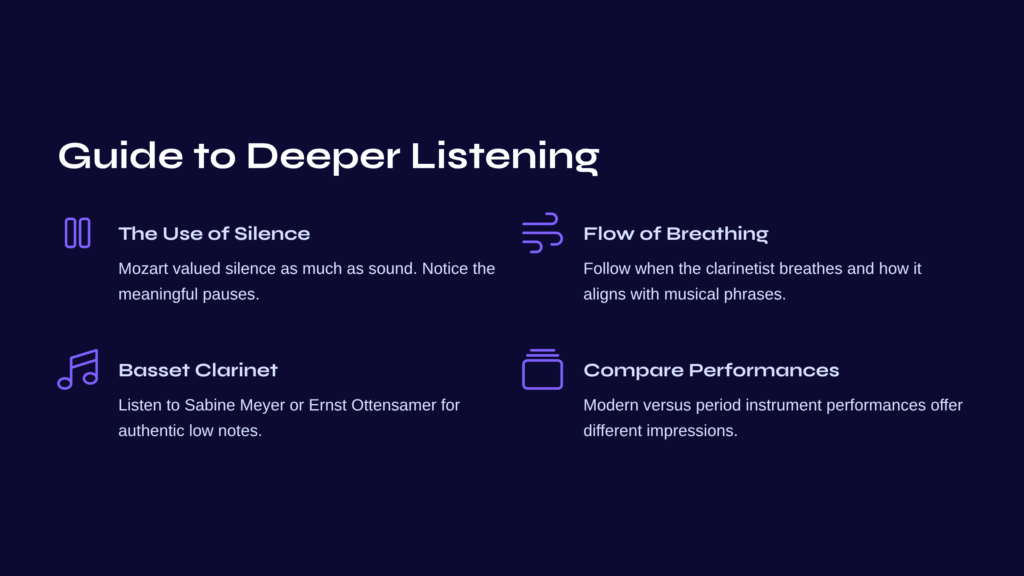
A Guide to Deeper Listening
To appreciate this Adagio more deeply, focus on several elements.
First, concentrate on the use of silence. Mozart valued silence as much as sound. The moments when the clarinet catches its breath, when the strings pause—all have meaning.
Next, follow the flow of breathing. Listen to when the clarinetist breathes, how that breathing aligns with the musical phrases, and you’ll feel the music more vividly.
If possible, definitely listen to a basset clarinet version. Performances by Sabine Meyer or Ernst Ottensamer are excellent choices. Experiencing the depth of low notes originally intended will give you a completely different emotional impact.
Also interesting is comparing modern performances with period instrument performances. Each gives different impressions.
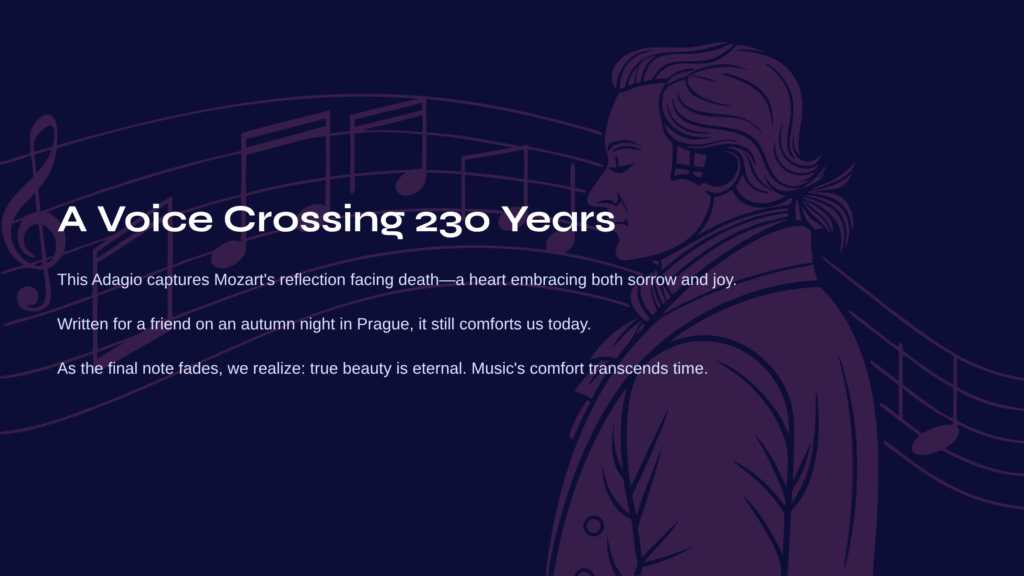
A Voice of Comfort Crossing 230 Years
Ultimately, this Adagio is one human’s deep reflection translated into musical notes. Mozart’s state of mind facing death—a generous heart capable of embracing both sorrow and joy—is contained within.
This eight-minute piece, written by a musical genius for his friend on an autumn night in Prague over 230 years ago, still comforts us today. Though times change and the world grows complex, the emotions felt deep in the human heart perhaps don’t change much.
As the clarinet’s final note fades into the air, we realize: true beauty is eternal, and comfort conveyed through the language of music transcends time.
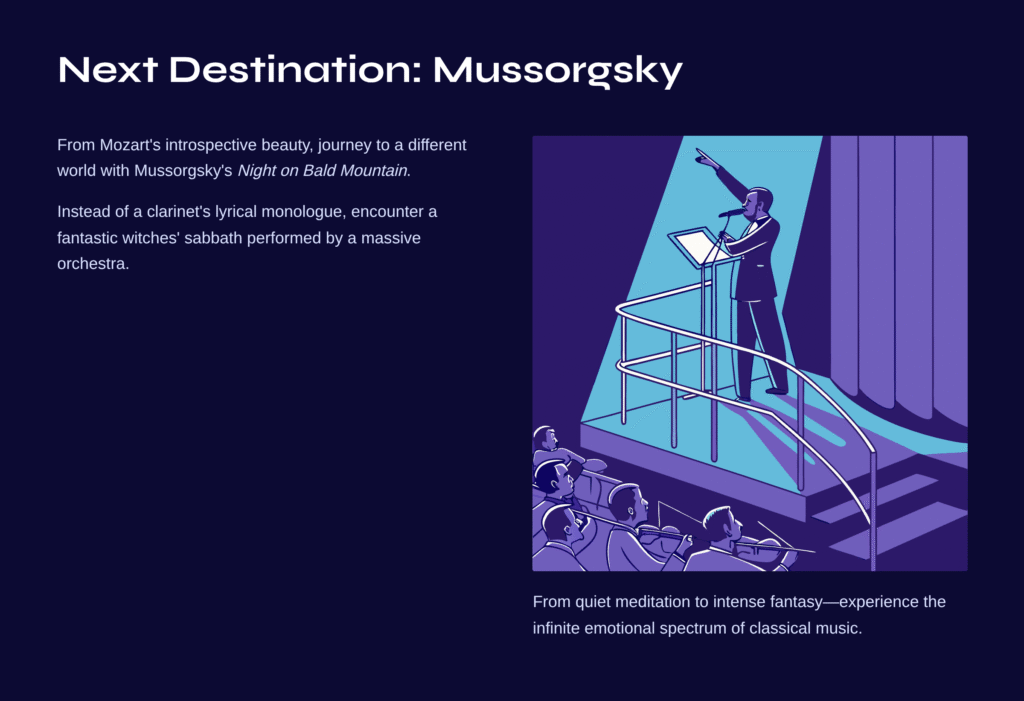
Next Destination: Mussorgsky’s “Night on Bald Mountain”
Shall we journey from Mozart’s transparent, introspective beauty to a completely different world? Mussorgsky’s Night on Bald Mountain is a work where Russian music’s wild energy explodes. Instead of one clarinet’s lyrical monologue, encounter the fantastic and somber witches’ sabbath performed by a massive orchestra. If Mozart showed the depth of personal reflection, Mussorgsky paints collective madness and primitive vitality through music. From quiet meditation to intense fantasy—this is the infinite emotional spectrum that classical music offers.
